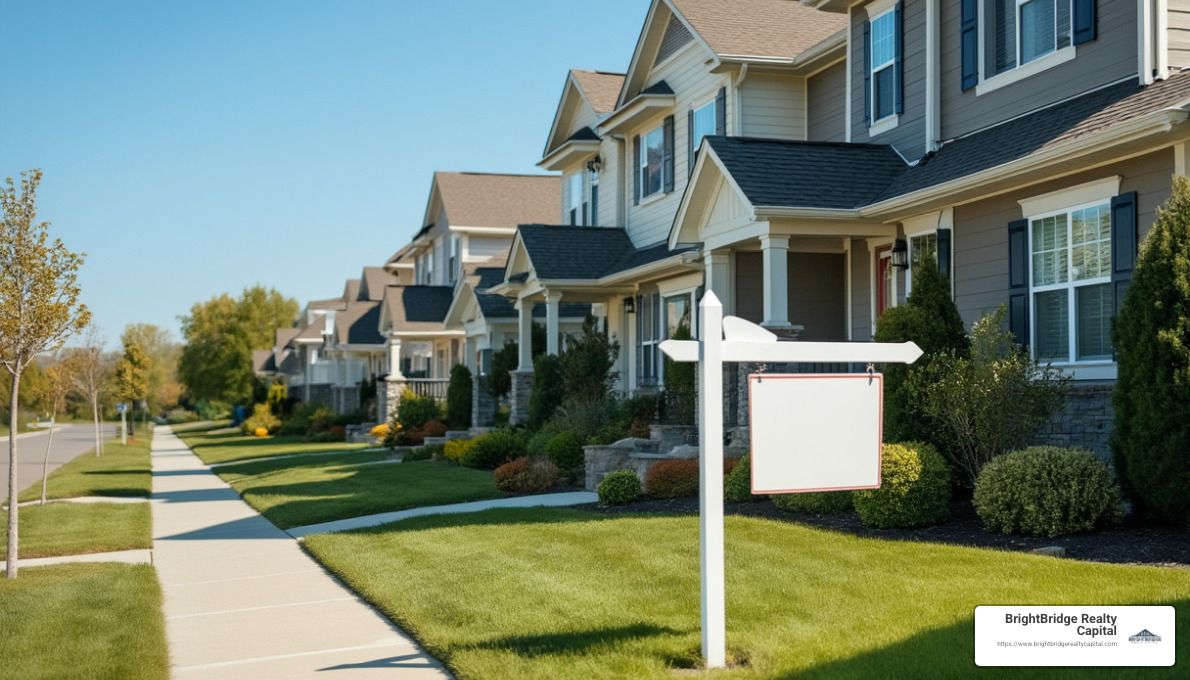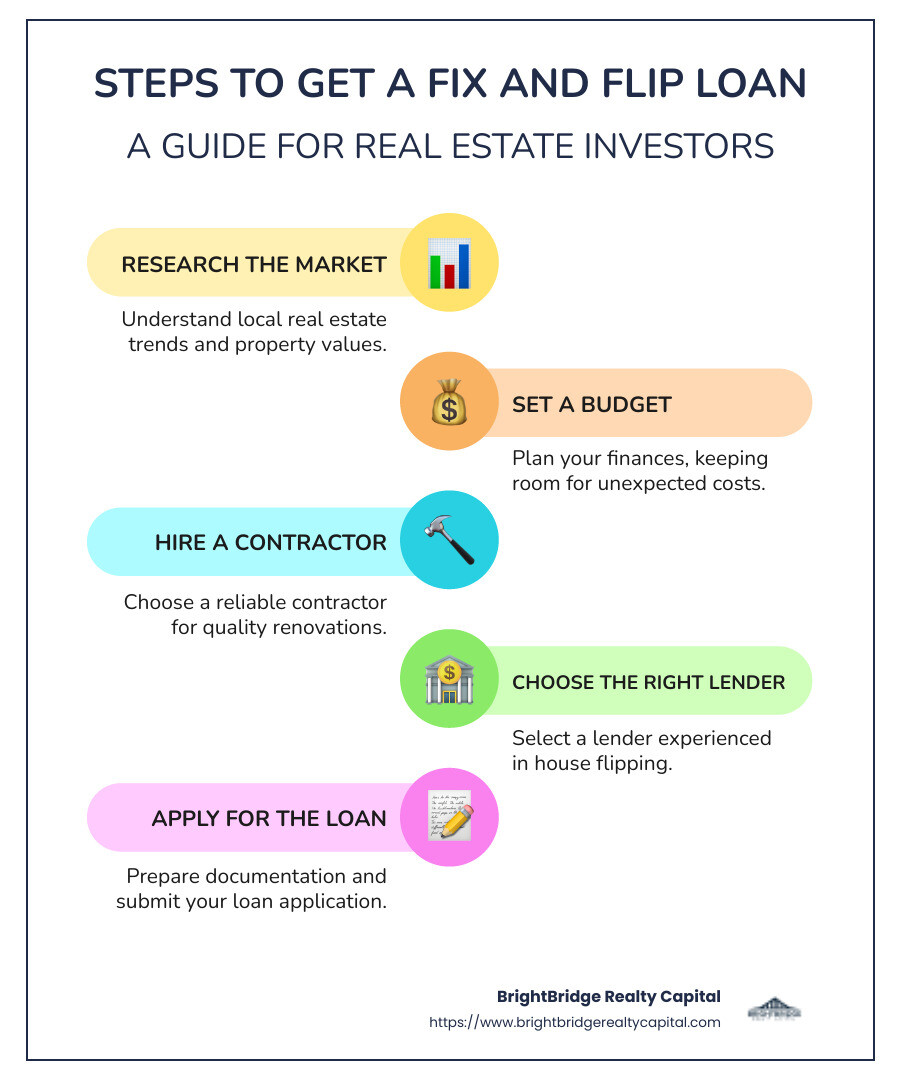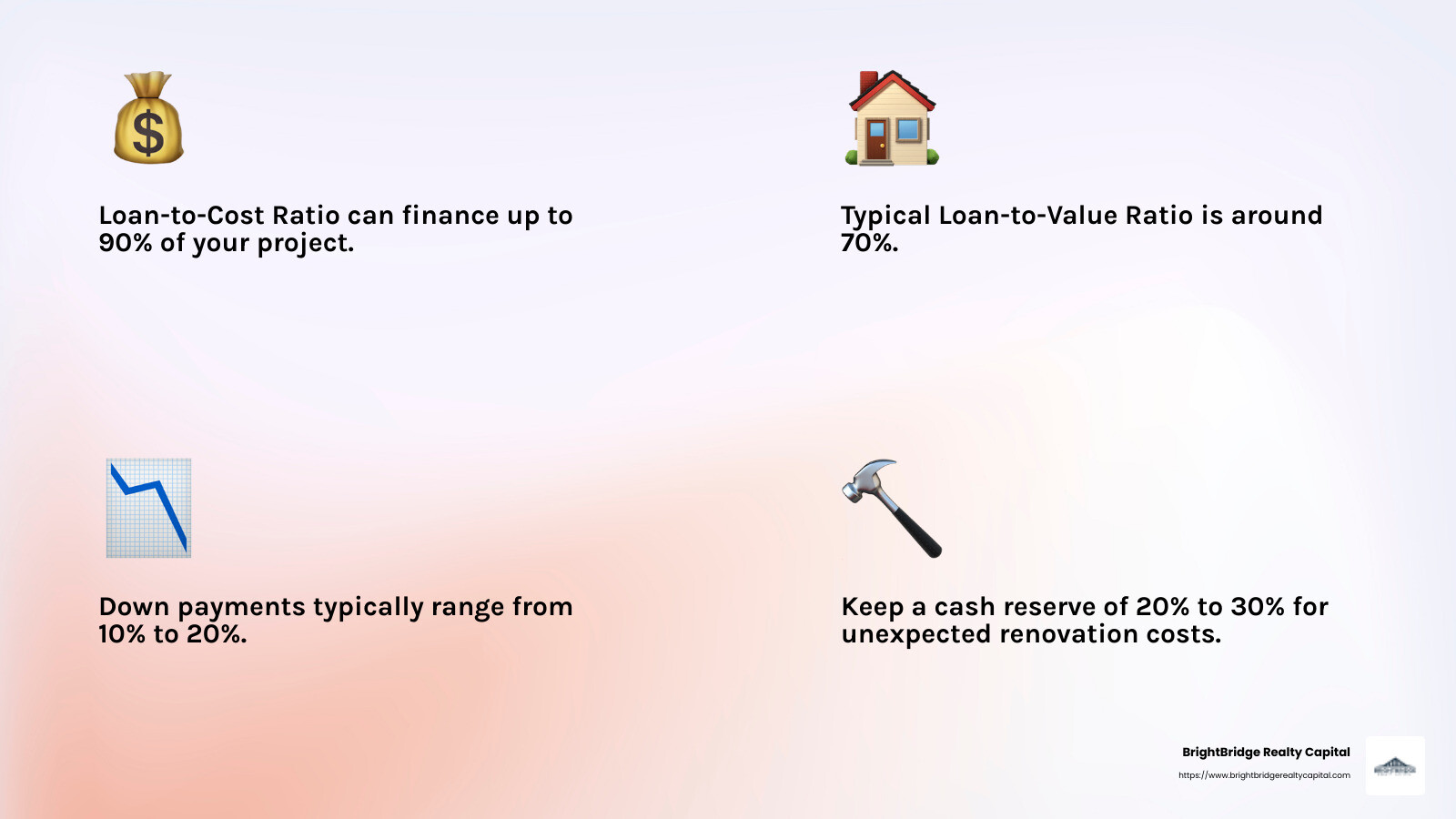Your Blueprint to Getting a Fix and Flip Loan

How to get a fix and flip loan can feel like an elusive puzzle for many budding real estate investors. The steps may seem daunting, but with the right guidance, it becomes an achievable goal:
- Research the Market: Gain a deep understanding of the local real estate trends.
- Set a Budget: Be precise and ready for unexpected costs.
- Hire a Good Contractor: Quality work is essential for maximizing profit.
- Choose the Right Lender: Look for those with experience in the house-flipping industry.
In the world of real estate investment, fix and flip loans serve as a vital cornerstone, offering the financial leverage needed to transform distressed properties into profitable ventures. These loans enable investors to purchase, renovate, and resell properties efficiently.
BrightBridge Realty Capital, with its roots in New York, provides competitive, flexible financing solutions nationwide for ambitious real estate investors who seek speed and reliability. As you start on your journey into property investment, having accessible capital through a reputable lender like BrightBridge can make all the difference in turning your investment dreams into reality.

How to get a fix and flip loan word list:
Understanding Fix and Flip Loans
When it comes to financing a house-flipping project, not all loans are created equal. Fix and flip loans are specifically designed for real estate investors who need short-term financing to buy, renovate, and sell properties quickly. Let's break down the main types of these loans to help you choose the right one for your project.
Loan Types for Fix and Flip Projects
- Hard Money Loans
- Hard money loans are popular among house flippers for their speed and flexibility. They're typically provided by private lenders rather than traditional banks. These loans are secured by the property itself, meaning the property serves as collateral. Hard money loans often come with higher interest rates, but they offer quick access to capital, which is crucial in competitive markets.

Home Equity Line of Credit (HELOC)
- A HELOC allows you to borrow against the equity in your current home. It's a revolving line of credit, which means you can borrow, repay, and borrow again as needed. This option can be beneficial if you have substantial equity in your home and prefer a lower interest rate compared to hard money loans.
Cash-Out Refinancing
- This involves refinancing your existing mortgage for a larger amount than you currently owe and taking the difference in cash. It's a way to tap into your home's equity for funding your flip project. While it may offer favorable interest rates, it also increases your mortgage debt, so consider this option carefully.
Each loan type has its pros and cons, and the best choice depends on your specific circumstances, including the project's timeline, your creditworthiness, and your risk tolerance.
Short-Term Financing
Fix and flip loans are inherently short-term, usually ranging from 12 to 18 months. This short duration aligns with the nature of house flipping, where the goal is to renovate and sell the property quickly to repay the loan and realize a profit.
Understanding these loan options and their features is crucial for any aspiring real estate investor. With the right financing in place, you can focus on changing properties and growing your investment portfolio.
As you consider your options, BrightBridge Realty Capital offers custom solutions to meet the unique needs of fix and flip investors. With their expertise and resources, you can confidently steer the complexities of real estate financing.
How to Get a Fix and Flip Loan
Preparing Your Application
Getting a fix and flip loan starts with preparing a solid application. This involves a few key steps:
Market Research: Understand the local real estate market. Identify neighborhoods with high potential for return on investment. Networking with real estate agents and other investors can provide valuable insights.
Budget Planning: Create a detailed budget for your project. Include the purchase price, renovation costs, and any unexpected expenses. Overestimate your budget to cushion against unforeseen costs.
Contractor Hiring: Unless you plan to do the work yourself, hire a reliable contractor. Research local contractors, get references, and ensure they fit your budget and quality expectations.
Loan Application Process: Prepare your application by gathering necessary documentation, such as proof of income and credit history. You will also need a property evaluation to determine its potential value post-renovation.
Credit Score: A good credit score can improve your chances of securing a loan with favorable terms. Aim for a score of at least 620, though higher is better.
Documentation: Be ready with all required documents, including your credit report, tax returns, and details of the property you intend to flip.
Property Evaluation: Conduct a thorough evaluation of the property to estimate its after-repair value (ARV). This helps lenders see the potential profitability of your project.
Choosing the Right Loan Type
Selecting the right loan type is crucial for financing your flip:
Hard Money Loans: These are popular for their speed and flexibility. Offered by private lenders, they use the property as collateral. While interest rates are higher, the quick access to funds is a major advantage.
Private Money Loans: Similar to hard money loans, these come from private individuals or groups. Terms can be more flexible, but they often require strong relationships and trust.
Bank Loans: Traditional banks offer loans with lower interest rates but may require more documentation and have a slower approval process. They are less common for short-term flipping projects but can be an option if you have a strong financial profile.
By understanding your financing options and preparing a thorough application, you can secure the right loan for your fix and flip project. BrightBridge Realty Capital offers custom solutions to help you steer the complexities of real estate investing with confidence.
Key Considerations for Fix and Flip Loans
When planning your fix and flip project, there are several key financial aspects to consider. Understanding these will help you make informed decisions and avoid costly mistakes.
Loan-to-Cost (LTC) Ratio
The loan-to-cost ratio is crucial for determining how much a lender will finance relative to the total project cost. This includes both the purchase price and renovation expenses. BrightBridge Realty Capital, for example, provides up to 90% LTC, meaning you only need to cover 10% of the costs. This can significantly reduce your upfront financial burden.
Loan-to-Value (LTV) Ratio
The loan-to-value ratio compares the loan amount to the property's value. For fix and flip loans, lenders often use the property's after-repair value (ARV) to calculate LTV. A typical maximum LTV is 70%, ensuring that the loan amount doesn't exceed the property's potential value. This ratio helps protect both you and the lender from financial risk.
Down Payment
Your down payment is a critical upfront cost. It typically ranges from 10% to 20% of the purchase price. For a $200,000 property, you might need $20,000 to $40,000 as a down payment. This is an essential factor to consider when planning your budget.
Renovation Costs
Renovation costs can vary widely depending on the property's condition and your renovation plans. It's common to encounter unexpected expenses during renovations, so it's wise to keep a cash reserve of 20% to 30% of your budget. This cushion can help you handle surprises without derailing your project.

By understanding these key considerations, you can better steer the financial aspects of your fix and flip project. A well-prepared budget and a clear understanding of loan terms are essential for success in real estate investment. Up next, we'll tackle some frequently asked questions about fix and flip loans, including the popular 70% Rule.
Frequently Asked Questions about Fix and Flip Loans
What is the 70% Rule?
The 70% Rule is a guideline that helps investors determine the maximum price they should pay for a property to ensure profitability. It suggests that you should not pay more than 70% of the property's after-repair value (ARV) minus the renovation costs. For instance, if a property's ARV is $200,000 and you estimate $30,000 in renovation costs, the maximum purchase price should be:
[ \text{Maximum Purchase Price} = (200,000 \times 0.70) - 30,000 = 110,000 ]
This rule helps ensure that you have a profit margin after accounting for purchase, repair, and selling costs.
How do interest rates compare?
Interest rates for fix and flip loans can vary based on the lender and the type of loan. Typically, these loans have higher interest rates compared to traditional mortgages due to their short-term nature and higher risk. Rates can range from 8% to 12% or more. It's important to shop around and compare offers from different lenders. BrightBridge Realty Capital, for example, offers competitive rates to help maximize your potential returns.
What are common pitfalls?
While fix and flip projects can be profitable, there are common pitfalls to watch out for:
Underestimating Costs: Renovation expenses can quickly add up. Always budget extra for unforeseen issues.
Overestimating ARV: Be realistic about the property's potential value post-renovation. Overestimating can lead to financial loss.
Poor Market Research: Failing to understand the local real estate market can result in buying properties that are hard to sell.
Hiring the Wrong Contractor: A bad contractor can delay your project and inflate costs. Always vet your contractors thoroughly.
Lack of Patience: Rushing into purchases or sales can lead to mistakes. Take your time to find the right property and buyer.
By being aware of these pitfalls and planning accordingly, you can increase your chances of success in the fix and flip market.
Next, we'll dive into the conclusion, highlighting how BrightBridge Realty Capital can provide you with fast closings, competitive rates, and a seamless process for your fix and flip ventures.
Conclusion
As we wrap up our exploration of how to get a fix and flip loan, it's clear that the right partner can make all the difference in your real estate investing journey. BrightBridge Realty Capital stands out by offering fast closings, often within a week, allowing you to act quickly and seize opportunities in a competitive market.
Our competitive rates are designed to maximize your returns, ensuring that your investment remains profitable. Whether you're a seasoned investor or just starting out, our loan options are custom to meet your specific needs.
What truly sets us apart is our seamless process. From application to funding, we streamline every step to make your experience as smooth and efficient as possible. With direct lending, there are no intermediaries, which means fewer problems and a faster path to your next successful flip.
If you're ready to take the next step or need more information, visit BrightBridge Realty Capital to explore our services and see how we can support your fix and flip projects. Let's turn your real estate visions into reality.


